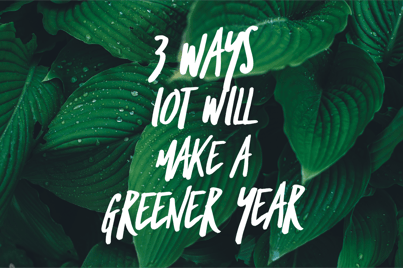The Internet of Things (IoT) is an industry that is only getting bigger. Currently, the industry is projected to reach 50 billion connected devices worldwide by 2020. Fiscally, Cisco predicts that the IoT market will generate an expected $14.4 trillion in increased revenues by 2022. As we head deeper into 2017, it is a good time to look at all the ways that IoT innovations will affect the world--including the environment. Here are three ways that IoT will make consumers and companies more environmentally efficient in the coming months:
1. Energetic efficiency
As smart sensors become more integrated into our lives, cutting costs by showing us exactly what energy is being used where, the question of energy efficiency will become paramount. Though it is impossible to fully predict what kind of cost to the environment so many devices will have, all businesses in the IoT industry have an incentive to invest in these innovations if they want a piece of the projected $470B annual revenues.
There is an added benefit of businesses remaining competitive in the global marketplace. This Ericsson report indicated that information and communication technologies could help cut 63.5 Gt of GHG emissions by 2030.
In practice, this means everything from smart air filters, to smart light sensors, to my favorite innovation–smart water meters. These meters are incredibly useful in monitoring water usage, quality, temperature and pressure. They also allow companies and to track consumption against neighborhood- and city-wide numbers, which is a helpful tool for those that aren’t sure if their usage is normal. These sensors also provide the added benefit of monitoring for leaks and floods. That way companies can track exactly how much water they are using, but more importantly, where it is going.
2. Out with the old, in with the alternative
It is expected that the demand for energy will increase by 37% by 2040, which will continue to spur the market demand for alternative energies. In-home energy generation systems are the next big innovation that will integrate alternative technologies with traditional. The “Smart Grid," a digital grid that works closely with the electrical grid to keep up with our energy demands, will allow companies and consumers to use traditional energy sources in conjunction with home-generated sources such as rooftop solar panels, wind turbines, and hydropower. These systems will be useful for both city-dwellers and people in more rural areas. New York City dwellers might consider investing in a green roof to reduce surface temperature upwards of 90˚F, whereas those in South Dakota might invest in wind turbine action.
3. Big green oil?
The oil industry is a huge player in global commerce, slated to grow at a trajectory that rivals Silicon Valley’s. This boom growth has (and will continue to) generate huge amounts of IoT data, which can be used to further refine processing technologies in a way that is environmentally responsible.
It may sound counter-intuitive, but the IoT can profoundly help those industries historically responsible for harmful methane emissions to operate in a greener way. IoT sensors are proving their increasingly refined abilities to capture and analyze important data that will allow companies to collect information about their wells, comply with regulatory standards, and maximize efficiency.
This is a great example of sensors getting the job done where people cannot. Sensing technologies allow companies to isolate emissions in real time, preventing long-term emissions pollution, as well as environmental catastrophe.
It’s too soon to see exactly what the long-term implications of IoT are on our world, both globally and environmentally. But it makes sense for the industry to focus on sustainable solutions, and not just to a fiscal end--the new year isn’t just a time to consider new innovations, but also an opportunity to think about how we can create healthy, lasting environmental impact for our future generations.


